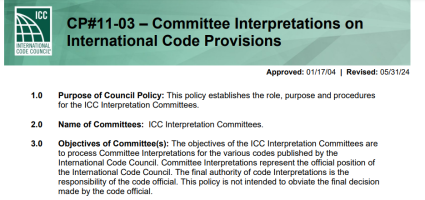jar546
CBO
When a municipality adopts a building code, either independently or as mandated by a state statute, the specific code versions referenced in the statute and ordinance apply. For example, if a jurisdiction adopts the 2021 International Code Council (ICC) suite, including the IBC, IRC, IPC, IMC, IEBC, IECC, IPMC, and referenced standards like NFPA 70, those are the official, enforceable documents.
However, many of these codes have accompanying Commentary editions. These Commentaries mirror the code language but include explanations, background information, and practical examples to clarify intent. Despite the clarity these Commentaries provide, code professionals often hear that the Commentary is not adopted as part of the official code, making it an unreliable reference in official decisions.
This position overlooks the building official's statutory authority to interpret the code. Per section R104.2 of the International Residential Code (IRC):
In this sense, the Commentary becomes indirectly enforceable. The building official uses it to understand the intent of the code and make educated decisions. This approach benefits the entire industry, as the Commentary provides a single, consistent source for interpretation. Relying on this resource helps foster uniformity across jurisdictions, reducing confusion and disputes.
At The Building Code Forum (TBCF), professionals frequently discuss how Commentary can support clear, consistent interpretations. The Forum offers a space for code officials, inspectors, and industry professionals to exchange experiences and clarify common misunderstandings. If the Commentary helps an official make an informed, defensible decision within the framework of R104.2, then its purpose is being fulfilled.
Ultimately, the Commentary is not a rulebook but a guide. The building official's authority to interpret the code responsibly ensures that the intent of the code is upheld while providing clarity and consistency for the public and the industry alike. If you're navigating these questions in your jurisdiction, join the conversation at The Building Code Forum to gain insights from colleagues across the country.
What are your thoughts on using the Commentary in code interpretations? Let's discuss it on the Forum.
However, many of these codes have accompanying Commentary editions. These Commentaries mirror the code language but include explanations, background information, and practical examples to clarify intent. Despite the clarity these Commentaries provide, code professionals often hear that the Commentary is not adopted as part of the official code, making it an unreliable reference in official decisions.
This position overlooks the building official's statutory authority to interpret the code. Per section R104.2 of the International Residential Code (IRC):
The Commentary often provides critical context that helps officials meet this responsibility. While it may not be binding law, it is a vetted resource from the code's authors and serves as a valuable tool when crafting interpretations consistent with code intent."The building official shall have the authority to render interpretations of this code and to adopt policies and procedures in order to clarify the application of this code’s provisions. Such interpretations, policies and procedures:
- Shall be in compliance with the intent and purpose of this code.
- Shall not have the effect of waiving requirements specifically provided for in this code."
In this sense, the Commentary becomes indirectly enforceable. The building official uses it to understand the intent of the code and make educated decisions. This approach benefits the entire industry, as the Commentary provides a single, consistent source for interpretation. Relying on this resource helps foster uniformity across jurisdictions, reducing confusion and disputes.
At The Building Code Forum (TBCF), professionals frequently discuss how Commentary can support clear, consistent interpretations. The Forum offers a space for code officials, inspectors, and industry professionals to exchange experiences and clarify common misunderstandings. If the Commentary helps an official make an informed, defensible decision within the framework of R104.2, then its purpose is being fulfilled.
Ultimately, the Commentary is not a rulebook but a guide. The building official's authority to interpret the code responsibly ensures that the intent of the code is upheld while providing clarity and consistency for the public and the industry alike. If you're navigating these questions in your jurisdiction, join the conversation at The Building Code Forum to gain insights from colleagues across the country.
What are your thoughts on using the Commentary in code interpretations? Let's discuss it on the Forum.

